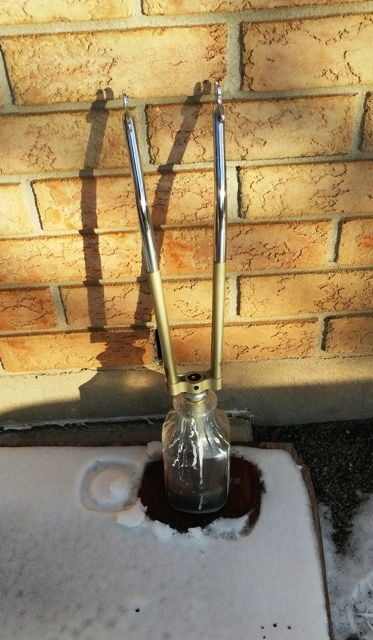Just an idea on mitigating the danger of using lye.
This worked for me but might not work for you so please think carefully before following my lead. I used heavy winter clothing and gloves and eye protection.
I tried sawing out my stuck stem but once I got most of the sawing done I wanted to spray in some more PB blaster to assist before twisting. I tapped in a small slot screwdriver where the stem wouldn't peel away from the steerer tube and the blade chipped the threads of the steerer. I decided to try the lye to prevent me inadvertently causing further damage. I would be concerned about the lye damaging the paint of a seat tube. I wasn’t concerned about the steerer tube as it's usually out of sight and if paint were damaged the touch up paint won't be seen. Ultimately there was no damage to my paint but every bike company used different paint so your results may vary. I was also very nervous of splatter from a lye solution.
I waited until after a cold night (-14c or -7f). In my backyard I have a spot where we had a garden that is now filled in with fine crush where I have to install some bricks. I put down a piece of old plywood as a base. I added about two large spoonfuls of lye powder into a plastic juice bottle and added about two cups of cold tap water. I positioned the forks with the stuck stem in the plastic bottle and stood back. There was almost no reaction so I removed the forks and added a bit more lye powder and then the forks and repeated that until a reaction started. At first it was a very minor bubbling, but as the day came and the sun warmed the air the reaction began to speed up. By now there was about 200gr (just shy of half a pound) of lye crystals in 2 cups of water which is far stronger a mixture than the online recipes I'd seen suggesting 200gr to a liter (about 3 cups) of water.
The dimple in the snow on the left is where the bottle sat for the first 10 minutes. Melting snow around the jug only occured between the 2nd and 3rd times I checked to see if there was any movement. Even then there was a very small amount of bubbling in the solution. After about 10 minutes I removed the forks and inserted a large steel screwdriver and tapped the wedge. The stem parts remained stuck so forks went back in the bottle. I tried again 10 minutes later, and again 10 minutes after that.

At that point I used a hammer against the screwdriver and the stem began to move out. After a few hard strikes, the stem slipped out. I immediately rinsed off the entire piece, inside and outside of the steer tube and the forks as well in case the lye had splattered on the forks and in case the lye is bad on chrome. At that time it was still around -5c or 23f and the outside of the plastic bottle was only mildly warm (similar to the heat felt when holding a takeout coffee cup). I didn't photo the remains of the stem but the part of the stem that had been in direct contact with the lye solution (including inside the stem) was very melted but the last two inches which were deep inside the steerer tube showed almost no effect from the solution and showed no sign of any of the penetrants. I had used (PB Blaster and ATF/Acetone mixture). Based on that I would assume that Jobst Brandt was correct when he said that penetrants can't always pass between a stuck stem and the steerer tube due to the corrosion expanding and blocking the way On a whim I inserted the remaining piece of the stem into the bottle but I moved the bottle directly onto the crush. I wanted to see how much stem would be dissolved. Adding the remaining stem was a bad idea as the day was warming rapidly.
I went to my garage and forced rags through the inside of the steerer tube to clean out any debris. I will still have to polish the inside of the tube to ensure there is nothing to catch the next stem, when I rebuild the bike.
After about 10 minutes I returned to the backyard to clean up. By now the sun was directly shining on the brick wall behind the plastic bottle. While the air was still below 0c or 32f the wall and the lye solution had warmed up considerably. The heat generated by the solution had melted a hole in the bottle and the solution had bubbled out onto the crush. Just a sliver remained of the aluminum stem.
In retrospect - I should have chosen a stronger bottle and I should have placed the bottle of solution in a large pail with a half inch of water already in it at the very start. As soon as the stem was free I should have immediately added more cold water into the bottle to weight it down and prevent it tipping over and to water down the solution. I should then have added more water to the outer pail to keep it cool. I should not have continued to soak the remainder of the stem.
I would not try this solution in warmer weather as it may react too fast but I would do it again in cold weather as the low temperature seemed to slow the reaction considerably. I would also consider doing it just at dusk to keep solar heat out of the equation and I would always do this outside!